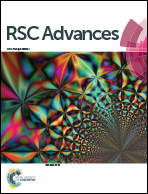Size-dependent CdSe quantum dot–lysozyme interaction and effect on enzymatic activity†
Abstract
Herein, protocols for modifying hydrophobic CdSe quantum dots with 3-mercaptopropionic acid (MPA) to generate hydrophilic moieties and their size-dependent (2.5 and 6.3 nm) interaction with lysozyme are reported comprehensively. The interaction of MPA-capped water-soluble quantum dots with lysozyme (Ly) was investigated, and a range of techniques such as static fluorescence spectroscopy and synchronous fluorescence spectroscopy were used to quantify QD–lysozyme binding isotherms, exchange rates, critical flocculation concentrations, and the compositions of mixed QD–lysozyme complexes. The results demonstrated that the binding of QDs with lysozyme induced conformational changes in lysozyme. QDs were able to enhance the enzymatic activity of lysozyme in a highly efficient dose-dependent manner. It was concluded that smaller-sized QDs were found to bind poorly to lysozyme, but produced a greater enhancement in enzymatic activity compared with larger QDs. In summary, a comprehensive characterization of the stability of lysozyme-bound QDs is a necessary step for their potential use as intracellular delivery vectors and imaging agents.


 Please wait while we load your content...
Please wait while we load your content...